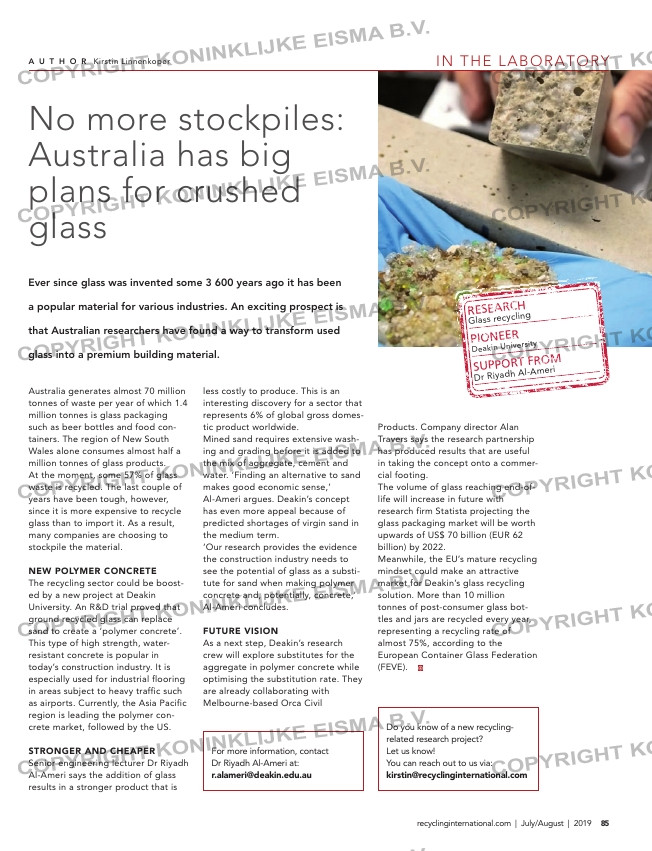Page 85 from: West Coast report + Plastics Special

IN THE LABORATORY
No more stockpiles:
Australia has big
plans for crushed
glass
Ever since glass was invented some 3 600 years ago it has been
a popular material for various industries. An exciting prospect is
that Australian researchers have found a way to transform used
glass into a premium building material.
Australia generates almost 70 million
tonnes of waste per year of which 1.4
million tonnes is glass packaging
such as beer bottles and food con-
tainers. The region of New South
Wales alone consumes almost half a
million tonnes of glass products.
At the moment, some 57% of glass
waste is recycled. The last couple of
years have been tough, however,
since it is more expensive to recycle
glass than to import it. As a result,
many companies are choosing to
stockpile the material.
NEW POLYMER CONCRETE
The recycling sector could be boost-
ed by a new project at Deakin
University. An R&D trial proved that
ground recycled glass can replace
sand to create a ‘polymer concrete’.
This type of high strength, water-
resistant concrete is popular in
today’s construction industry. It is
especially used for industrial flooring
in areas subject to heavy traffic such
as airports. Currently, the Asia Pacific
region is leading the polymer con-
crete market, followed by the US.
STRONGER AND CHEAPER
Senior engineering lecturer Dr Riyadh
Al-Ameri says the addition of glass
results in a stronger product that is
less costly to produce. This is an
interesting discovery for a sector that
represents 6% of global gross domes-
tic product worldwide.
Mined sand requires extensive wash-
ing and grading before it is added to
the mix of aggregate, cement and
water. ‘Finding an alternative to sand
makes good economic sense,’
Al-Ameri argues. Deakin’s concept
has even more appeal because of
predicted shortages of virgin sand in
the medium term.
‘Our research provides the evidence
the construction industry needs to
see the potential of glass as a substi-
tute for sand when making polymer
concrete and, potentially, concrete,’
Al-Ameri concludes.
FUTURE VISION
As a next step, Deakin’s research
crew will explore substitutes for the
aggregate in polymer concrete while
optimising the substitution rate. They
are already collaborating with
Melbourne-based Orca Civil
Products. Company director Alan
Travers says the research partnership
has produced results that are useful
in taking the concept onto a commer-
cial footing.
The volume of glass reaching end-of-
life will increase in future with
research firm Statista projecting the
glass packaging market will be worth
upwards of US$ 70 billion (EUR 62
billion) by 2022.
Meanwhile, the EU’s mature recycling
mindset could make an attractive
market for Deakin’s glass recycling
solution. More than 10 million
tonnes of post-consumer glass bot-
tles and jars are recycled every year,
representing a recycling rate of
almost 75%, according to the
European Container Glass Federation
(FEVE).
For more information, contact
Dr Riyadh Al-Ameri at:
[email protected]
Do you know of a new recycling-
related research project?
Let us know!
You can reach out to us via:
[email protected]
A U T H O R Kirstin Linnenkoper
85recyclinginternational.com | July/August | 2019
RESEARCH
PIONEER __
_________
SUPPORT FR
OM
Glass recyc
ling
Deakin Uni
versity
Dr Riyadh A
l-Ameri
85_inthelab.indd 85 08-08-19 11:23



